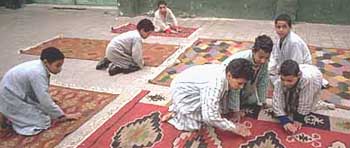Child Labor
Essential Purpose
Child labor is both a historical issue and a current global issue. And, as our world becomes more and more interdependent, global issues become both national and local in scope. The Industrial Revolution created the conditions for the rise of child labor. As more and more cheap labor was needed to keep the factories and mines operating, it is easy to see how the work force included more and more children. However the outcry against this abuse of children led to legislative reform in the United States. But, in many parts of the world this abuse of children is still occurring and there is still a need to be concerned about the plight of these children.
This module will help students understand the reasons for the rise of child labor in the United States in the 1800s; to understand how the outcry against the abuses of children led to legislation to ban it; and, to understand why child labor is still a problem today in many parts of the world. Although it focuses on the industrial revolution in the United States and the conditions that created the movement for child labor laws, it also helps children see that many of these same conditions exist in many parts of the world today.
As students learn about the abuses of child labor in this country and how legislation addresses these abuses, they will come to understand that they can help do something about these abuses worldwide.

Child Labor in the Mideast – edited from United Nations website
National History Standards
Era 6 (1870-1900)
The Development of Industrial United States
Standard 3: The rise of the American labor movement and how political issues reflected social and economic changes.
- Standard 3A: The student understands how the “second industrial revolution” changed the nature and conditions of work.
- Examine historical perspective
- Analyze the causes and consequences of the industrial employment of children
- Examine historical perspective
State/Local Standards
States should align these modules to their own state/local standards as appropriate.
Essential Questions
- How were lives of children impacted by the industrial revolution?
- Why was it necessary to pass laws to protect the lives of children in the United States and other industrialized countries?
- How can the quality of working conditions for children be improved in countries that still use child labor?
Essential Content
Impact of the Industrial Revolution
- Need for Cheap Labor
- Technological Advances
- Benefits of the Industrial Revolution
- Changes in the Social Structure
- Increased wealth for the few
- Low wages for the workers
Child Labor
- Need for a cheap labor supply for industry
- Effect on education for children
- Health and safety consequences
- Low wages/poor working conditions
Growth of the Movement for Child Labor Laws
- Outcry from parents
- Work of reformers
- Documentation of poor working conditions through articles and pictures
- Effects of lobbying efforts through the use of the media, cartoons, and songs
Child Labor Practices Today
- Areas of the world most affected by child labor abuses
- World organizations to help improve the working conditions for children
- Children’s effort to improve working conditions for children
Essential Skills
Standards in Historical Thinking
Standard 1: Chronological Thanking
- Identify in historical narratives the temporal structure of a historical narrative or story
Standard 2: Historical Comprehension
- Evidence historical perspective
Standard 3: Historical Analysis and Interpretation
- Compare and contrast differing sets of ideas, values, personalities, behaviors, and institutions
Standard 5: Historical Issues: Analysis and Decision Making
- Formulate a position or course of action on an issue.
Summative Assessment
This summative assessment and scoring guide should be reviewed with students prior to using the activities in the module. Students should do the assessment after the activities have been completed.
Essential Questions Addressed by the Summative Assessment
- How were lives of children impacted by the industrial revolution?
- Why was it necessary to pass laws to protect the lives of children in the United States and other industrialized countries?
- How can the quality of working conditions for children be improved in countries that still use child labor?
|
Prior Knowledge
Problem
Role/Perspective
Product/Performance
Criteria for an Exemplary Response
|
Now that you have learned how children were treated in many of the industrialized countries of the world during the industrial revolution and how laws were passed to help make conditions better for them, you are ready to come up with some recommendations of your own to assist children in other parts of the world who are suffering under many of these same conditions.
Many people believe that the problem of child labor today cannot be solved without the help of children themselves from all over the world. It is those who how have suffered from child abuse who know its affect on children and what can be done to stop it. But, it is also children like you who have knowledge of child abuse and how it was solved in other countries who can now use this knowledge to contribute to a worldwide solution. Together you may be able to make some recommendations that the adults of the world can implement to solve the problem. You are the research consultant to the Ambassador to the United Nations from the United States. You have been asked to prepare a research report for the Ambassador to use at a forthcoming Conference on Child Labor Abuses Around the World. In the report, you will explain why the use of child labor has changed over time in the United States. Based on your evidence make a list of five recommendations that you think could put an end to abusive child labor practices worldwide. Be prepared to support your recommendations with specific information from this module. In your research report, be sure to include:
|



